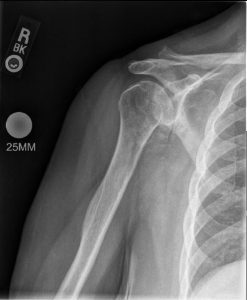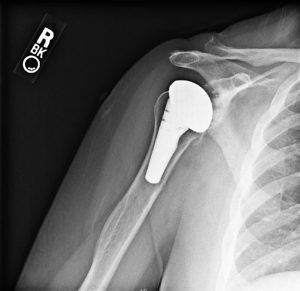Total Shoulder Arthroplasty Rehabilitation
A total shoulder is performed for degenerative changes of the glenohumeral (shoulder) joint in patients with an intact rotator cuff. To perform a total shoulder arthroplasty one of the rotator cuff muscle tendons has to be taken down and repaired. This muscle is the subscapularis muscle and runs across the anterior (front) portion of the shoulder. The subscapularis performs the function of internally rotating the arm/shoulder and is on tension when the arm is externally rotated or with shoulder extension.

Before Shoulder Replacement
In general, initial rehabilitation after total shoulder replacement focuses on three areas:
- Maintain shoulder mobility
- Protect the subscapularis repair
- Maintaining elbow, wrist, and finger motion
As you rehabilitate your shoulder you will be passed from through phases of rehabilitation based upon both time and your progress with rehab.
Immediate Postop:
- Ice for swelling and postoperative pain
- You may shower on Postoperative day 5 without the wound covered
- Take one 325mg aspirin per day to help prevent blood clots
- Take stool softeners to prevent constipation

After Total Shoulder Replacement
Week 1-6 (Restore ROM)
- No extension. One must always be able to see the elbow – even while sleeping and should place a small pillow behind the elbow while lying flat.
- No external rotation past neutral x 4 weeks. At 4 weeks increase to 30 degrees external rotation
- Forward Flexion as tolerated
- Abduction to 90 with the arm in internal rotation
- Passive Range of Motion and Active Assisted ROM only for 6 weeks
- Sling for 6 weeks at night. After 2 weeks the sling can be removed for daily activities
- Full elbow, wrist, and finger range of motion three times per day. No lifting great than 1 pound with biceps
- Pendulums with 20 cm diameter circle maximum
- Active scapular retraction and shrugs started immediately
- Remove the sling at the conclusion of week 6
Week 7-12 (Start Strengthening)
- Increase external rotation to maximum 45 degrees
- Begin active ROM as tolerated except for the restriction to ER
- Begin strengthening of shoulder as the patient approaches full ROM
- Wall pushups
- Therabands to strengthen the biceps, infraspinatus, and supraspinatus
- Gradually increase strengthening of the trapezius, rhomboids, deltoid, cuff muscles (except subscapularis), and forearm muscles toward the end of week 12.
- Scar mobility
- The goal is full active ROM by week 12
Week 13-18 (Strengthening & Activity training)
- Increase ER to 60 degrees or as tolerated
- Can begin strengthening of the subscapularis
- Passive stretching to work on areas of tightness
- Joint mobilizations if needed
- Continue more aggressive strengthening of the shoulder girdle as well as working on scapular retraction and scapular mechanics with your therapist
- Transition toward full activity
Week 19 and on (Increased Activity)
- Work toward full activity without restrictions
- Continue home exercise program and stretching
Additional Principles:
- The principles of surgery around most joint is similar:
- Protect any repairs
- For TSA we protect the subscapularis repair for 3 months and the biceps tenodesis for 6 weeks.
- Obtain full range of motion
- Strengthen the muscles surrounding the joint
- Protect any repairs
- You will have xrays performed at your 2 week and 6 week and 12 week appointments.
- If sutures or staples need to be removed this will be done at the 2 week appointment.
- If you develop any increase in pain, fevers, chills, wound drainage, shortness of breath, or any other concerns please contact the office at 307-578-1955.
